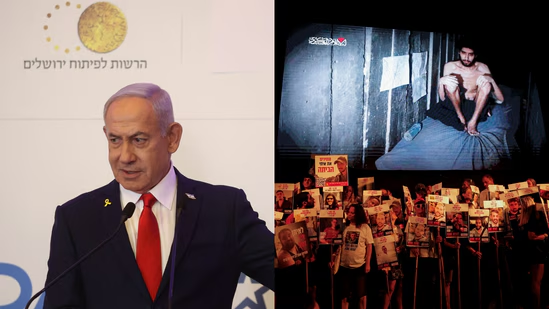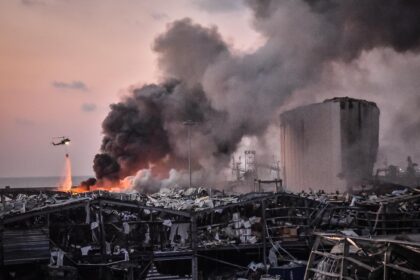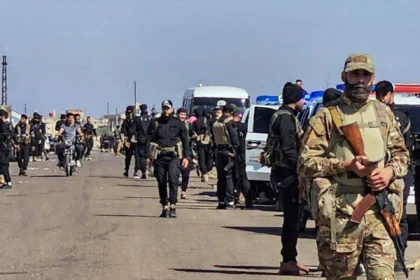Netanyahu in Shock After Hamas Video Shows Israeli Hostage Digging Own Grave in Gaza War Horror
The Israel–Gaza conflict has, over the years, presented the world with some of the most heartbreaking scenes of war, displacement, and human suffering. However, the latest video that surfaced from Hamas-controlled territory marks an especially dark and disturbing moment in this already devastating chapter of Middle Eastern conflict. In the video, an Israeli hostage—his identity not officially released—is seen digging what appears to be his own grave under duress, surrounded by masked Hamas operatives. The footage sent shockwaves through the Israeli public and triggered a somber and emotionally charged response from Prime Minister Benjamin Netanyahu.
The Israeli government, already under pressure over its handling of the ongoing conflict, is now grappling with the moral, psychological, and strategic implications of this chilling video. Netanyahu, addressing the nation shortly after the footage began circulating on both traditional and social media platforms, expressed “profound shock” and condemned the act as “barbaric terrorism that mocks every value of humanity.” His voice, usually measured in national addresses, betrayed an unmistakable tremble of distress and fury.
This moment is not just another entry in the long ledger of wartime atrocities—it represents a psychological escalation. Israel has long accused Hamas of using psychological warfare, but this visual evidence of cruelty has broken through previously unseen emotional thresholds. For many Israelis, the image of a fellow citizen forced to dig his own grave evokes not only anger but a deep-rooted historical trauma that reverberates through generations.
Military analysts in Tel Aviv and Jerusalem have raised critical questions: Was this video staged for psychological impact alone, or is it a harbinger of more disturbing tactics to come? Intelligence circles believe the footage may be just one of several propaganda tools Hamas intends to use as leverage in its information war, especially at a time when global narratives around the Israel–Gaza conflict are increasingly polarized.
At the same time, the Israeli Defense Forces (IDF) have been ordered to intensify efforts to locate and rescue all hostages still believed to be held in underground tunnels across Gaza. With over a dozen hostages still unaccounted for, the pressure on Israel’s intelligence services has never been greater. Senior IDF commanders, speaking on condition of anonymity, revealed that operations have now expanded beyond conventional military raids, incorporating cyber surveillance, signal intelligence, and collaborations with international agencies.
For families of hostages, this video has added a devastating layer of grief. “We didn’t know if he was alive or dead,” said one family member of a missing hostage who feared their relative was the man in the video. “But watching that… it’s a pain words can’t describe.”
Meanwhile, in the international arena, governments have reacted with a mixture of condemnation and concern. The United States, United Kingdom, France, and several EU nations issued statements calling the act a clear violation of international humanitarian law. The United Nations Human Rights Office has called for an independent investigation, though the feasibility of such a probe remains questionable given the ongoing hostilities and Hamas’ refusal to engage with many global institutions.
Yet beyond politics and military action, this video has punctured the collective psyche of a nation. It has reignited debates in Israel about national security, intelligence failures, prisoner swaps, and the ethical limits of warfare. For some, it reaffirms the necessity of Israel’s hardline stance; for others, it poses urgent questions about the cost of prolonged conflict.
As the war in Gaza rages on, this haunting video may prove to be a turning point—not only in public sentiment but also in how future diplomatic and military decisions are shaped.
The emergence of the disturbing Hamas hostage video—where an Israeli captive is seen digging his own grave—has not only rattled Israel’s political establishment but also deepened the psychological dimensions of the ongoing Gaza conflict. This war, like many before it, is no longer confined to bullets and airstrikes. It is being fought just as fiercely in the minds of civilians, soldiers, and political leaders, with each side deploying psychological operations (psy-ops) to tilt public morale, international perception, and domestic support.
The Use of Psychological Warfare
From Hamas’ perspective, the release of such a horrifying video is a calculated move. It is meant to destabilize Israel’s internal social fabric by injecting fear and emotional chaos. This form of warfare is brutal, but it is not new. Over the years, groups like Hamas and Hezbollah have increasingly turned to media-driven intimidation tactics, leveraging shock value to provoke overreactions, delay negotiations, or sway public opinion.
Psychological warfare is especially potent in a hyper-connected digital era. The video, within minutes of appearing on an encrypted Telegram channel, was mirrored across Twitter (now X), TikTok, and Instagram, garnering millions of views. Despite efforts by Israeli authorities and social media platforms to curb its spread, the footage has firmly planted itself in the public consciousness.
Israeli media outlets debated heavily on whether to air even blurred stills from the clip. While many refused out of ethical concerns and national security sensitivity, others opted for partial disclosures, arguing that shielding the public from such realities might enable further governmental complacency or failure.
The result: a nation increasingly on edge, vulnerable to anxiety, rage, and polarizing discourse.
Netanyahu’s Calculated Response
Prime Minister Benjamin Netanyahu’s address after the video’s emergence was both emotional and tactical. He described the video as “proof of who we are fighting—a terrorist enemy with no moral restraint.” But beyond rhetoric, Netanyahu’s words were also designed to harden public resolve, refocus attention on the necessity of the Gaza campaign, and shield his administration from increasing domestic criticism.
His leadership, however, is under mounting scrutiny. The hostage situation exposes several hard truths. Despite technological superiority, Mossad and Shin Bet have thus far failed to produce breakthroughs on hostage rescues. Multiple military incursions into Gaza have ended without recovering a single living hostage. Families are frustrated. Critics on both the left and right are now demanding a transparent public inquiry into the government’s hostage policy—especially regarding failed negotiation backchannels and prisoner swap hesitations.
In past conflicts, Israel had shown willingness to engage in lopsided prisoner swaps. The most famous of these was in 2011, when 1,027 Palestinian prisoners were released in exchange for a single Israeli soldier, Gilad Shalit. Today, Netanyahu faces a much more polarized nation, where security hawks and bereaved families diverge sharply on whether such deals should be repeated.
The Human Toll on Both Sides
While Israeli families grieve over the possibility of loved ones suffering unthinkable psychological and physical torture, Gazan civilians are also enduring relentless trauma. Weeks of bombardment have left thousands dead and entire neighborhoods in ruins. Hospitals are overwhelmed, food and clean water are increasingly scarce, and schools have been converted into makeshift shelters for displaced families.
Yet, Hamas’ decision to release a hostage video, rather than focus on humanitarian appeals or diplomatic leverage, signals a troubling shift in priorities. The message seems to be that psychological damage to Israel takes precedence over any international goodwill or efforts at negotiation.
International observers, including the International Committee of the Red Cross (ICRC) and Médecins Sans Frontières (Doctors Without Borders), have condemned the video and demanded immediate clarity on the condition of all hostages. But Hamas has largely rebuffed such calls, accusing these agencies of bias and failing to address the suffering of Palestinians in equal measure.
Social Media: The New Battlefield
Social media has become the accelerant in this firestorm. What once took days or weeks to disseminate—videos, photographs, or testimonies—now reaches the world in seconds. In this particular incident, digital footage has become a tool not only of documentation but also of manipulation. Some accounts even repackaged the video with dramatic soundtracks and pro-Hamas subtitles, aiming to boost propaganda engagement.
On the Israeli side, official government accounts have intensified their own digital war. They’ve released counter-videos showing humanitarian aid being delivered to Gaza, civilian warnings prior to airstrikes, and emotional testimonies from hostage families pleading with the global community for support.
Yet the digital war is not fought fairly. Algorithms don’t distinguish between fact and propaganda, between grief and celebration. As a result, social media has become a dark theatre of psychological warfare—where every retweet, like, or comment helps push someone’s narrative forward.
Diplomatic Fallout and Global Reactions
The video has also put world leaders in a bind. While many Western nations issued strongly worded condemnations, others—particularly in the Global South—have remained notably silent, wary of being drawn into a highly charged conflict with limited diplomatic gains. China and Russia, for instance, expressed generic concern without naming either party, signaling a broader strategy of non-alignment and opportunistic neutrality.
Meanwhile, U.S. Secretary of State Antony Blinken called the video “deeply disturbing” and reiterated America’s commitment to assisting in hostage recovery efforts. However, there remains skepticism within Israel about how much practical support can actually be expected, especially given the Biden administration’s increasingly strained balancing act between supporting Israeli security and appeasing progressive constituencies concerned about Palestinian suffering.
The United Nations Security Council convened a closed-door session following the video’s release but, as with many previous meetings, failed to produce a binding resolution due to disagreements among permanent members.
Looking Ahead: A Conflict Without Clear Resolution
This incident has once again underscored that the Israel–Gaza war is not just a physical confrontation—it is a deeply entrenched ideological, emotional, and psychological struggle. The hostage video has not only sharpened battle lines but has also redefined what this war now entails: fear as a weapon, trauma as strategy, and perception as the new frontline.
As global leaders call for restraint and civilians on both sides cry out for peace, the question remains: will this war end with any real resolution—or only more footage, more graves, and more grief?
As the war between Israel and Hamas drags on, the humanitarian and emotional costs continue to deepen. Nowhere is this more evident than in the quiet despair and growing anger of the families of Israeli hostages. The hostage crisis—once a secondary subplot to the larger Gaza narrative—has become the most emotionally charged focal point of the conflict. With the release of the harrowing Hamas video showing a hostage digging his own grave, public attention has turned from political posturing to intimate, human suffering.
Anxious Families Left in the Dark
Israeli officials have confirmed that more than 100 citizens remain unaccounted for, believed to be held in various underground or hidden locations within the Gaza Strip. For their families, each day is a torturous wait—filled with unanswered calls, vague military briefings, and media reports that oscillate between hope and horror.
One such story is that of the Aharoni family. Their 23-year-old son, Nadav, was captured on October 7 when militants stormed the border community of Nir Oz. His mother, Elisheva Aharoni, has become one of the most recognizable faces of the hostage families movement—appearing on news broadcasts and social media almost daily. “We don’t know if our children are alive. The government is asking us to be patient, but they won’t even tell us what they know,” she told reporters outside the Knesset in Jerusalem.
The government’s lack of transparency, many families argue, borders on indifference. Several believe that intelligence agencies have more information than they are disclosing—whether to protect sensitive sources or to avoid political fallout.
Government Inertia or Strategic Restraint?
Prime Minister Netanyahu’s administration has defended its approach to the hostage crisis as one of “strategic restraint,” stating that premature disclosures or hastily organized rescue missions could risk the lives of the captives. But this justification is no longer sufficient for many citizens.
Behind closed doors, Mossad and Shin Bet have reportedly attempted to engage mediators in Qatar, Egypt, and Turkey to open indirect lines of negotiation with Hamas. But so far, talks have been fruitless. Hamas insists on lopsided prisoner exchanges—terms that the Israeli government currently finds politically untenable.
According to leaks in Israeli media, at least two proposed exchange deals were considered but ultimately rejected due to internal cabinet disagreement and public backlash. One such proposal would have swapped 40 Palestinian prisoners—including those convicted of violent attacks—for just five hostages. Right-wing parties threatened to collapse the coalition if the deal went forward, fearing it would encourage further abductions and embolden Hamas.
This political gridlock has only inflamed public protests. Families of the hostages have now set up protest camps outside the Defense Ministry in Tel Aviv, demanding action—or at the very least, clarity.
Hostages as Political Capital
It is a bitter truth of modern warfare: hostages are not just victims—they become currency. In the propaganda war, Hamas uses them to draw attention, create international leverage, and demoralize the Israeli population. For Netanyahu’s government, the hostages present a complex equation. Appearing too lenient on negotiations may cost him politically, especially among the far-right base. Appearing too rigid may lead to tragic outcomes and accusations of abandonment.
This duality has paralyzed decision-making. And as time passes, the condition of the hostages—psychologically, physically, and medically—remains a source of increasing dread.
The Hamas video served one clear function: to pressure Netanyahu by sparking public outrage. It worked. But instead of prompting immediate negotiations, it has led to further political fracturing and harsher rhetoric on both sides.
International Mediation: A Fragile Hope
There is growing recognition that a resolution to the hostage crisis will not be possible without outside intervention. The United States, Egypt, and Qatar have all signaled willingness to mediate, but none possess the necessary leverage to force Hamas into a deal or push Israel into concessions.
U.S. President Joe Biden publicly condemned the video and reaffirmed support for Israeli efforts to free the hostages. However, American diplomats are increasingly urging Netanyahu to at least consider humanitarian corridors or limited ceasefires—conditions that could serve as trust-building steps toward a hostage release.
In response, Israeli officials insist that any pause in fighting would only give Hamas time to regroup and entrench. “We cannot give them oxygen while our citizens are dying,” one defense official stated anonymously. The window for diplomacy is narrowing—and with each passing day, so is the hope that all hostages will return home alive.
Media Ethics and the Coverage Debate
The hostage video has raised new questions about media responsibility. While some Israeli channels chose not to air any footage or images, international media—particularly sensational outlets—have treated the clip as breaking news, giving it wide circulation. Critics accuse such outlets of enabling Hamas’ psychological warfare by spreading fear-inducing content.
Journalists now walk a tightrope: how to report accurately without amplifying terrorist messaging. Media watchdog groups have called for clearer standards, emphasizing the need to protect the dignity of victims and avoid becoming unwitting mouthpieces for propaganda.
At the same time, social media has complicated the issue. While mainstream broadcasters may exercise caution, citizen journalists and anonymous users face no such ethical guidelines. Footage of hostages—real or manipulated—circulates unchecked on Telegram, TikTok, and dark web forums, feeding a cycle of rumor, misinformation, and trauma.
Israel’s Policy at a Crossroads
Israel now finds itself at a policy crossroads. Should it continue its hardline approach, banking on military victory and the slow unraveling of Hamas’ grip on Gaza? Or should it shift tactics and consider more flexible diplomatic channels to ensure the hostages’ survival?
Public sentiment is divided. A recent poll by the Israel Democracy Institute shows that 51% of Israelis support negotiation for hostages even if it involves prisoner exchanges, while 43% believe in continuing military pressure without compromise. The remaining 6% are undecided—a testament to the complexity and emotional weight of the issue.
Whatever path Israel chooses, the stakes are immense. The nation’s conscience, credibility, and cohesion are all on the line.
Also Read : Army Officer Assaults SpiceJet Staff at Srinagar Airport Over Excess Baggage Dispute








